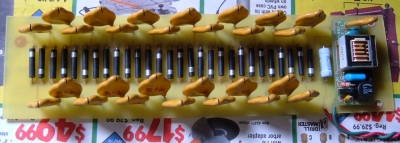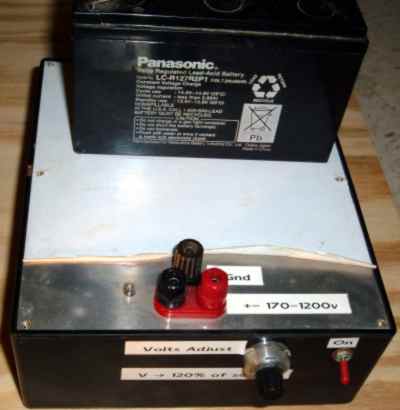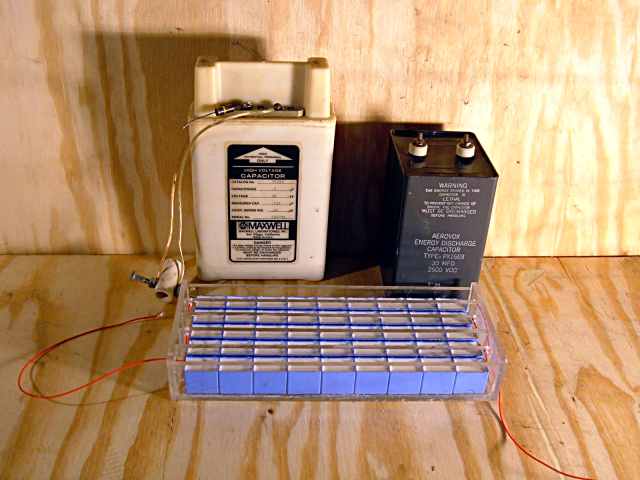 This uses an inverter for a CCFL backlight, available from Digi-Key
and lots of other places. This one is rated to drive two lamps, and
puts out on the order of 6 watts. I put a series resistor in the input
line to control surge current when it is fired up across a discharged
capacitor. This version makes something a little over 30 kV, and is
used to charge a very nice .5 uF Maxwell capacitor I managed to get.
It's the kind we didn't want Saddam to have, the series inductance
of this puppy is under .02 uH! That's a difficult number to maintain
with wire leads, so we use a transmission line of copper flashing and
mylar.
For lower voltages, one can just use fewer stages of multiplication.
This many stages rated laying out a little PCB board, made here.
This uses an inverter for a CCFL backlight, available from Digi-Key
and lots of other places. This one is rated to drive two lamps, and
puts out on the order of 6 watts. I put a series resistor in the input
line to control surge current when it is fired up across a discharged
capacitor. This version makes something a little over 30 kV, and is
used to charge a very nice .5 uF Maxwell capacitor I managed to get.
It's the kind we didn't want Saddam to have, the series inductance
of this puppy is under .02 uH! That's a difficult number to maintain
with wire leads, so we use a transmission line of copper flashing and
mylar.
For lower voltages, one can just use fewer stages of multiplication.
This many stages rated laying out a little PCB board, made here.There's a couple little secrets to making this work well. The inverter puts out AC at about 50 kHz, so the diodes have to be fast enough for that. If you look closely, the capacitors on the board have builtin spark gaps, which flash over at about 2.5 kV. This is crucial to protect the diodes from excessive reverse voltages when the big cap discharges, and the little caps aren't all equal. These work fine with the 3kv diodes I managed to get, nothing fries that shouldn't. The diodes are Diotec DD300 types, rated at 3 kV and 20 mA, plenty for this. The capacitors are .01 uF safety caps, also obtained surplus. TV's used to have these in some of the horizontal circuits for safety, and across the power line. Don't think they are used for that any more, as this was actually a little dangerous in the presence of all that dust inside most old sets. The series resistor is 8.2 ohms, 3 watts, from Digi–Key. This is just to keep the little 1 amp fuse on the inverter from frying when the output is shorted.
 Here is another version that is regulated. The outputs of the little
inverters are more or less proportional to the inputs. So, we took
a nice big box (room for a 12 volt gel cell in there) and made a
regulated ± 1200v supply. This has a 10 turn pot for adjustment,
a nice blinking neon danger indicator, and most importantly, a quiet
output (no ripple) so it is good for things like photo–tubes and
Geiger counters. No voltage multiplication is used here, just a diode and
a two stage RC filter for the output. Sorry, I do not have a schematic
of this one, but will make one if someone asks. It's a pretty simple
circuit, IIRC, just an LM358 op amp, a zener reference, and a good old
IRL 3705 as a current booster for the op amp output. One of the output
voltages is divided down to compare to the reference. The red stuff
you can see on the board is Glyptal, a very good insulating paint. Without
this, the high value resistors used in the voltage divider would have
their conductance swamped by surface leakage. This is more heat resistant
than paraffin.
Here is another version that is regulated. The outputs of the little
inverters are more or less proportional to the inputs. So, we took
a nice big box (room for a 12 volt gel cell in there) and made a
regulated ± 1200v supply. This has a 10 turn pot for adjustment,
a nice blinking neon danger indicator, and most importantly, a quiet
output (no ripple) so it is good for things like photo–tubes and
Geiger counters. No voltage multiplication is used here, just a diode and
a two stage RC filter for the output. Sorry, I do not have a schematic
of this one, but will make one if someone asks. It's a pretty simple
circuit, IIRC, just an LM358 op amp, a zener reference, and a good old
IRL 3705 as a current booster for the op amp output. One of the output
voltages is divided down to compare to the reference. The red stuff
you can see on the board is Glyptal, a very good insulating paint. Without
this, the high value resistors used in the voltage divider would have
their conductance swamped by surface leakage. This is more heat resistant
than paraffin.
 Here's a picture of the box, with the battery we use. This makes the
thing totally portable, and floating from ground, which can be nice.
One portable use of this is something we are playing with over on
the chemistry side of things, a detonator for high explosives that
needs no primary explosive at all. That's nice for both safety
and toxicity. For this we use a 30 uF 2500 volt
capacitor, obtained surplus, and a spark gap to switch the output into
what amounts to a miniature rail gun that is the detonator. Next time
I make a spark gap for this energy level, I will leave room for
pipe caps on the ends. This gap is noisy.
Here's a picture of the box, with the battery we use. This makes the
thing totally portable, and floating from ground, which can be nice.
One portable use of this is something we are playing with over on
the chemistry side of things, a detonator for high explosives that
needs no primary explosive at all. That's nice for both safety
and toxicity. For this we use a 30 uF 2500 volt
capacitor, obtained surplus, and a spark gap to switch the output into
what amounts to a miniature rail gun that is the detonator. Next time
I make a spark gap for this energy level, I will leave room for
pipe caps on the ends. This gap is noisy.
 These are a few of the large energy storage capacitors we have here.
Both the .5uF/30kV Maxwell and the 30uF/2.5kV Aerovox store about
225 joules. When fired through a spark gap they will make you
jump out of your skin (or pee yourself). Although this isn't all
that much energy, it comes out really fast, in the billions of watts
during the pulse. It is enough that the magnetic field will rip
speaker wire apart. We will have to do special things for the Maxwell
to get down near its intrinsic series inductance, as in make a big
flat transmission line. The spark gap you see hanging off the
Maxwell was made with two 1/4–20 bolts and a 4–40 screw as
the trigger electrode. Alignment was insured by drilling the main hole
all the way through in one pass, and tapping the same way. Next time
I make one of these, I will leave room for end caps. This thing sounds
about like a pistol shot. Not healthy indoors.
These are a few of the large energy storage capacitors we have here.
Both the .5uF/30kV Maxwell and the 30uF/2.5kV Aerovox store about
225 joules. When fired through a spark gap they will make you
jump out of your skin (or pee yourself). Although this isn't all
that much energy, it comes out really fast, in the billions of watts
during the pulse. It is enough that the magnetic field will rip
speaker wire apart. We will have to do special things for the Maxwell
to get down near its intrinsic series inductance, as in make a big
flat transmission line. The spark gap you see hanging off the
Maxwell was made with two 1/4–20 bolts and a 4–40 screw as
the trigger electrode. Alignment was insured by drilling the main hole
all the way through in one pass, and tapping the same way. Next time
I make one of these, I will leave room for end caps. This thing sounds
about like a pistol shot. Not healthy indoors. The plexiglass box in the foreground is the primary capacitor for our Tesla coil, and other things. It is 50 .47uF 1000V caps in series, serpentine style. In use, the box gets filled with mineral oil for cooling, and the whole thing is wrapped in copper flashing to cut inductance. Even without these steps, the peak discharge current is such that it heats up the "little" silver plated 18 ga wire quickly when fired at a 120 hz rep rate by the 1 kw neon sign transformer we use. Haven't measured the peak current, but it must be pretty huge. We didn't really need a 50kV rating here, but did need to get a capacitor that the neon sign transformer could charge in one half cycle, and had these lying around.